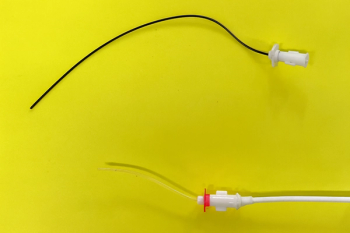
Urine strips: Maximizing the diagnostic value
Most diagnostic reagent strips used to perform routine urinalysis in veterinary laboratories were designed for human use.
Most diagnostic reagent strips used to perform routine urinalysis in veterinary laboratories were designed for human use. Although they do provide useful information to evaluate urine samples from animals, the results obtained with several diagnostic urine strips are unreliable.
Are you familiar with the limitations of the specific brand of diagnostic reagent strip used in your hospital?
The following list summarizes the limitations of most reagent strips and offers suggestions to maximize their diagnostic value:
1. URINE SPECIFIC-GRAVITY values of dogs and cats obtained with reagent strips are unreliable.
SUGGESTION: Use a properly calibrated refractometer to determine the values.
2. URINE PH test pads are designed to measure pH values to within 0.5 units. Because pH values usually are measured on a logarithmic scale, these strips often are too insensitive for reliable evaluation. Also, to prevent a false reduction in pH values when using multiple test reagent strips, prevent runover from the highly acidic protein test pad to the urine pH test pad by holding the strip horizontally.
SUGGESTION: Use a pH meter to determine pH results, especially when trying to measure relatively small changes in urine pH.
3. GLUCOSE TEST PADS contain labile enzymes (glucose oxidase and peroxidase). If the enzymatic action of these proteinaceous enzymes is impaired, test results will be unreliable.
SUGGESTION: Become familiar with the expiration date on the container. The life of enzymes in an unopened container of urine reagent strips may be prolonged by freezing the package. Check with the manufacturer for details.
4. BILIRUBIN REAGENT PADS are unreliable as screening tests in dogs because of a high percentage of false positive and false negative results. In contrast, positive bilirubin test results in cats usually are indicative of some underlying disease.
SUGGESTION: Consider positive or negative urine bilirubin test results in conjunction with other clinical findings.
5. THE OCCULT BLOOD TEST PAD may detect red blood cells, free hemoglobin or myoglobin.
SUGGESTION: Evaluate positive test results in conjunction with evaluation of urine sediment and other clinical findings.
6. PROTEIN TEST PADS routinely incorporated into multiple test reagent strips are based on a phenomenon called the "protein error of indicator dyes." These tests are approximately twice as sensitive to albumin compared to globulin, and three times more sensitive to albumin compared to muco-proteins. In addition, false positive results may occur if the urine pH is very alkaline.
SUGGESTION: Compare questionable results to another test method, such as the turbidometric sulfosalicylic acid test. Evaluation of urine protein-creatinine ratios may be helpful because they are a more reliable method to determine the magnitude of pathologic proteinuria.
7. UROBILINOGEN TEST PADS have not been useful in the routine evaluation of canine and feline urine.
SUGGESTION: Do not rely on uro-bilinogen test pads to screen patients for hemolytic disorders, hepatic disorders or patency of bile ducts.
8. NITRITE TEST PADS are used as an indirect indication of bacteriuria in humans. However, they provide uniformly false negative results in dogs and cats. False negative results associated with nitrite tests are associated with interference caused by ascorbic acid normally present in canine and feline urine.
SUGGESTION: Evaluate urine sediment and bacterial cultures to rule in or rule out bacterial urinary-tract infections.
Table 1: Correlation of some common urinary-tract diseases with expected proteinuria and urine-sediment findings
9. LEUKOCYTE TEST PADS give false positive results in most cats in absence of pyuria, and therefore are of no value in this species. Leukocyte test pads frequently give false negative results in dogs, even when pyuria is present. Although the test is specific for WBC in dogs, it is very insensitive.
SUGGESTION: Using standardized technique, urine sediment should be evaluated to detect, characterize and quantify white cells, (along with epithelial cells, renal casts, bacteria, yeast cells or hyphae, parasite ova and crystals). These cannot be detected reliably by macroscopic evaluation of urine with reagent strips.
Although the normal range of white cells (neutrophils) in urine sediment prepared from a 5-ml. aliquot of urine centrifuged at 2,000 to 3,000 rpm for five minutes has been reported to be zero to three white cells per high-power field (450X) in samples collected by cystocentesis, and zero to eight white cells per high-power field in catheterized or midstream voided samples, several variables that influence white-cell numbers should be considered (Table 2).
Table 2: Factors affecting numbers of structures in sediment
Tthere is no absolute cut-off point between upper numbers of "normal" white-cell numbers and lower limits of "abnormal" white-cell numbers.
Variation in results may be minimized by standardizing the procedure of preparing and analyzing urine sediment.
Because knowledge of urine specific gravity provides useful information on the relative concentrations of water and elements in urine sediment, urine sediment results should be interpreted in conjunction with urine specific gravity.
Although various types of diseases (inflammatory, infectious, neoplastic, etc.) may be recognized on the basis of positive findings, they cannot always be eliminated on the basis of negative findings.
For example, detection of a significant number of bacteria in association with pyuria indicates that the inflammatory lesion is active and has been caused or complicated by bacterial infection.
However, since bacteria are more difficult to detect than white cells, pyuria may appear to be unassociated with low numbers of bacteria. Therefore, urine obtained from patients with significant pyuria should be routinely cultured for bacteria.
Table 3: Normal vs. abnormal findings in urine sediment
Another example is interpretation of white-cell casts.
Observation of them indicates renal tubular involvement in the inflammatory process. However, white-cell casts rapidly degenerate to become granular casts.
In our experience, white-cell casts are uncommonly associated with bacterial infections of kidneys.
Therefore, absence of white-cell or granular casts does not exclude renal involvement in the inflammatory process.
The point is that the results of examination of urine sediment must be interpreted in combination with other clinical data, including the physical and chemical characteristics of urine (Table 1).
Dr. Osborne, a diplomate of the American College of Veterinary Internal Medicine, is professor of medicine in the Department of Small Animal Clinical Sciences, College of Veterinary Medicine, University of Minnesota.
Newsletter
From exam room tips to practice management insights, get trusted veterinary news delivered straight to your inbox—subscribe to dvm360.



